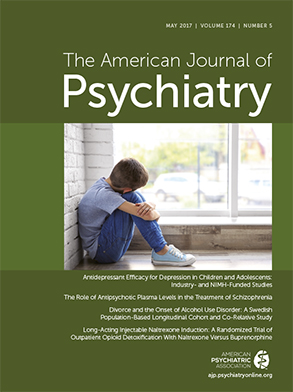Complicated, controversial clinical issues create problems for patients, their families, and their physicians. In recent years, some clinicians working with children and adolescents might have hesitated before recommending a selective serotonin reuptake inhibitor (SSRI), because of continued questioning in the media of the evidence for their effectiveness. In this issue, John T. Walkup, M.D., a leading child psychiatrist with expertise in clinical trials, reviews the relevant data to generate a more balanced perspective (
1), which promises to reduce the burden facing these clinicians. His review carefully evaluates the evidence supporting the use of SSRIs in children and adolescents with major depressive disorder, obsessive-compulsive disorder (OCD), or an anxiety disorder.
Questions on SSRI efficacy arose through an unusual path, as Walkup recounts. At the end of the 1990s, little data existed on antidepressant safety and efficacy in children and adolescents. Changes in the regulatory environment designed to address this problem led to a marked increase in safety and efficacy research. The research generated two sets of unexpected findings related to SSRIs, which stimulated controversy. First, questions arose regarding the adverse behavioral effects of SSRIs in some young people, including an increase in suicidal behavior and thoughts about suicide. Second, the magnitude of the clinical effect was smaller than anticipated from earlier, smaller studies in children and adolescents. Both sets of findings received support from an unbiased analysis of the data. Nevertheless, many reviews over the next decade highlighted these negative effects more prominently than the beneficial effects of the SSRIs, which also were evident at the time.
In his review, Walkup places the various findings in perspective. He finds that the results from government-supported and industry-supported studies yield different conclusions: independent studies supported by the National Institute of Mental Health (NIMH) produced stronger evidence of efficacy than did the initial industry-funded trials. Paradoxically, it is these industry trials that have been identified as potentially biased. Walkup also discusses possible reasons for the different results, including the higher number of study sites in the industry-funded than in the NIMH-funded trials. Previous reviews have emphasized this fact less strongly than Walkup does, placing more emphasis on the overall efficacy results of previous meta-analyses. Thus, Walkup notes the inverse correlation between the magnitude of the clinical effect and the number of sites in the study, which was much greater in industry-sponsored than government-supported studies of SSRIs. As patient-recruitment sites increase in number for the industry-funded trials, investigators leading such a multisite study face increasing problems in maintaining study quality, whereas the NIMH-funded trials used fewer sites as well as more extensive training of the investigators. Thus, Walkup and others argue that the smaller number of sites in NIMH-funded studies leads to research of higher quality, which accounts for the finding of larger clinical effects. It is these NIMH trials that families and clinicians can turn to when considering whether or not to use an SSRI as part of a comprehensive treatment plan for the adolescent or child with depression.
A second important point relates to the broader clinical context surrounding SSRI research, where findings differ in anxiety disorders, OCD, and major depressive disorder. The clinical effect of SSRIs is particularly large in the anxiety disorders, another fact Walkup emphasizes more strongly than some previous reviewers. Ironically, despite having the largest clinical effect for anxiety, SSRI use in pediatric anxiety disorders, unlike in OCD and major depression, does not have an indication from the U.S. Food and Drug Administration. Diagnosis represents one aspect of clinical context; the availability of treatments with efficacy similar to that of SSRIs represents another such aspect. For pediatric major depression, cognitive-behavioral therapy (CBT) represents the other established treatment beyond the SSRIs. Nevertheless, the data in this area also contrast with the data in the anxiety disorders. Specifically, CBT and SSRIs produce similar effects in the anxiety disorders. However, in the largest depression trial to compare SSRIs, CBT, and pill placebo, the clinical benefit of CBT was indistinguishable from placebo. Hence, smaller clinical effects in major depression may be more a feature of the clinical condition than a shortcoming of the SSRIs. Overall, different findings in different clinical contexts emphasize the need for a balanced perspective on SSRI use.
Walkup’s final point relates to achieving just such a balance, where he does the clinician a major service. Clearly, SSRIs can have adverse effects on behavior in children and adolescents. Moreover, even in government-funded studies of the highest quality, the magnitude of the clinical effect in major depression is not large. Nevertheless, Walkup reminds us that the efficacy data clearly do support the use of SSRIs in pediatric major depression, anxiety disorders, and OCD and that the benefits outweigh the risks in many clinical scenarios.
One can understand the controversy surrounding SSRIs by noting the context from which it arose. When considering this context, it is also important to remember the large burden to patients, families, and communities associated with pediatric mental disorders. Most importantly, when clinicians look beyond controversy to their patients’ clinical burden, Walkup’s perspective helps us carefully evaluate the efficacy data to choose the best treatment for children and adolescents with major depression, anxiety disorders, and OCD, and in particular, to consider the SSRIs as a reasonable therapeutic option for many of our patients.

